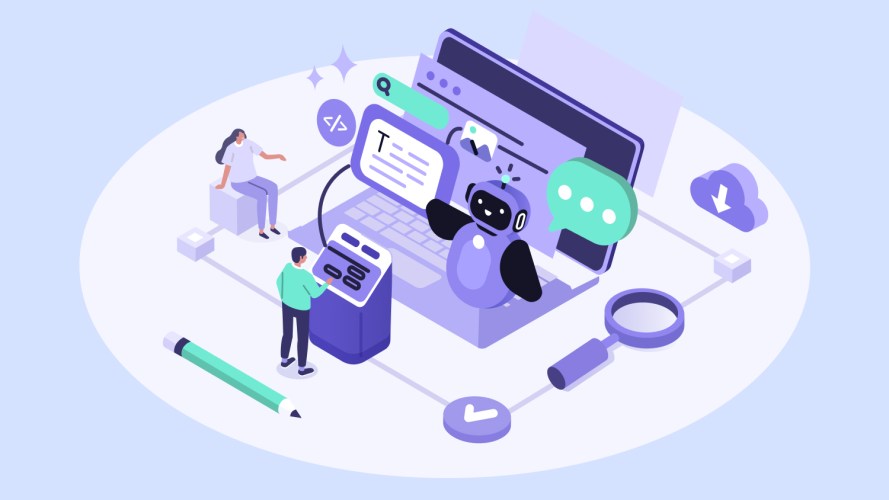Imagine this: it’s 2025, and you’re sitting in your office, reviewing your latest quarterly results. But instead of sifting through endless spreadsheets or static dashboards, a dynamic AI assistant is presenting real-time insights. It’s not just numbers on a screen. Your AI assistant is telling you which market trends are emerging, why your top product is outperforming in Europe, and even suggesting strategies to maximize next quarter’s growth. This isn’t science fiction. This is the new reality of AI and data analysis.
For business leaders, data has always been the foundation of great decisions. But the way we analyze and act on data is changing faster than ever. AI is no longer just a tool; it’s your strategic partner, turning mountains of data into clear, actionable insights. Whether you’re optimizing operations, personalizing customer experiences, or preparing for the unexpected, AI is giving leaders like you the confidence to make decisions that drive results.
AI doesn’t simply process data. It reveals hidden patterns, identifies opportunities, and offers solutions that were unimaginable even a few years ago.
At the core of this revolution are new technologies, new tools, new approaches, and new challenges. For companies, understanding these changes will create a competitive edge. For data professionals, it amplifies your ability to solve challenges. And for anyone curious about the future, it’s a glimpse into how technology is revolutionizing the way we work and live.
Discover Agentforce
Agentforce provides always-on support to employees or customers. Learn how Agentforce can help your company today.



What’s new: The evolution of AI and data analysis
AI is reshaping how we analyze and use big data, making the process faster, more accurate, and filled with new insights. Here’s a closer look at how AI is making a big impact on data analysis:
Turning data chaos into clarity
Instead of manually sorting through data, AI tools can clean, merge, and validate data, making it ready for analysis in a fraction of the time. In the past, data analysts and business teams have spent hours — sometimes even days — preparing data for analysis. Collecting unstructured data from different sources, checking for inconsistencies, and ensuring accuracy was exhausting and time-consuming. Now, new AI tools can do this automatically.
AI also takes this a step further by assisting with pattern recognition. Through advanced data mining techniques, AI can quickly identify data trends or correlations that might be hard for humans to spot — especially in massive datasets. From predicting future sales trends to spotting customer behavior patterns, AI’s ability to analyze data at scale means that businesses can uncover valuable insights that may have been missed.
In a recent episode of Experts of Experience, Kishan Chetan, Executive Vice President and General Manager of Salesforce Service Cloud, points out that this doesn’t only benefit the teams pulling together datasets; it also provides a better customer experience.
“Imagine you’re an airline and you could use all of your customers’ interaction either by phone or chat to understand the sentiment and understand intent. You can now proactively offer a discount on their next flight based on sentiment analysis. That’s the future.”
AI’s ability to streamline processes, uncover hidden insights, and personalize interactions is transforming how businesses operate. And, it’s redefining how they connect with their customers, paving the way for smarter, more empathetic experiences at every touchpoint.
The power of predictive modeling and real-time analysis
Historically, businesses would look at past data to make predictions about the future. While this method worked to an extent, it relied heavily on assumptions. AI takes predictive analytics and business intelligence to the next level by analyzing data to uncover the true cause-and-effect relationships that drive outcomes.
For example, retailers no longer need to rely solely on last year’s numbers to plan for the upcoming season. With AI, they can predict which products are likely to be in demand based on factors like current trends, social media activity, or even weather patterns, helping them stock the right products at the right time and minimize waste.
Real-time data analysis, data processing, and advanced business analytics mean companies across all sectors can make quick, data-driven decisions — whether it’s adjusting inventory levels, changing marketing tactics, or even customizing product offerings.
How AI is making smarter decisions and happier customers
AI isn’t only helping businesses make decisions faster. It’s also making those decisions smarter and more personalized. For example, in marketing, AI automation can provide personalization at scale. Rather than relying on broad, generic campaigns, AI enables companies to deliver targeted content that resonates with each customer, improving engagement and conversion rates.
AI also helps companies make better decisions by automatically detecting anomalies in their data. For instance, if a business is tracking sales performance, AI can flag sudden drops or spikes in activity that might indicate a problem, like a pricing error or a fraudulent transaction. Instead of waiting for human analysts to notice or investigate, AI can automatically trigger alerts, allowing businesses to act swiftly and address issues before they escalate.
Kishan Chetan shared an outstanding use case of this: “Imagine you’re having a whole bunch of calls around something broken in a fridge. What if you could take those different cases and proactively send out a notification to everybody who has that machine and ask them to go fix it?”
Deploy AI agents
with confidence
Get the blueprint to fast-track your Agentforce implementation and drive long-term success.



Improving data quality and data management
Data quality and data accuracy are the foundations of effective analysis, and AI is stepping up to make these better than ever. With new tools automatically spotting and fixing errors, businesses can rely on data that’s accurate and trustworthy. Instead of wasting time troubleshooting messy datasets, teams can focus on using their data to uncover insights and make smarter decisions.
As companies collect more and more data, managing that data efficiently has become essential. AI-powered tools simplify data integration by combining information from multiple sources, giving businesses a complete picture of their operations. With this clear view, organizations can make informed decisions that drive success.
Making data come alive: The future of data visualization
AI is also revolutionizing data visualization, making it more intuitive and engaging.
Rather than static charts, businesses now rely on dynamic dashboards that allow users to explore data interactively. AI-generated narratives accompany these visualizations, making complex insights accessible to non-technical teams. For example, an executive might review a dashboard that not only shows sales trends but also explains why certain regions performed better than others, complete with recommendations.
You can organize and present information using data visualization capabilities built directly into your CRM. This will help you tell visual stories to help everyone see, understand, and act on your data within a trusted data visualization platform.
Bringing it all together: AI agents as your data sidekick
What if you had a smart assistant who could clean, compile, and analyze your data, and then turn that analysis into an interactive, visual dashboard with recommendations? That’s what AI agents are here to do. Think of them as your personal data detectives, always on the job and ready to help.
AI agents are changing the game by making it easy to work with data regardless of your technical capabilities. They use tools like natural language processing, machine learning, and deep learning to let you ask questions and get real answers. So instead of digging through endless spreadsheets, you can just ask, “Why did our sales drop last month?” You’ll get a clear explanation, plus suggestions on how to fix it.
OpenTable boosts customer service with Agentforce
See how the company boosts productivity for service reps with AI agents and Service Cloud.



“AI agents are powered by LLMs. That means that the whole interaction is far more conversational, and its reasoning goes well beyond a rule-based system,” Kishan Chetan describes. “It truly has the ability to reason based on all of the data that’s in your system.”
These agents don’t just answer questions. They also keep an eye on your data 24/7, spotting problems or opportunities the moment they happen. Imagine getting a heads-up about a product running low in stock or a sudden spike in customer complaints. AI agents help you act fast, turning potential headaches into easy wins.
Kishan divides the core opportunities for applying AI agents into three broad categories:
1. Action oriented
These are the customer service interactions where a customer needs a quick piece of information. For example, they want a status update on an order delivery. This is very transactional and could be replaced by a voice call, chatbot, or agent interaction that can pull this information for a customer easily.
2. Order related
The second use is when a customer wants to engage further on an action. For example, they want to change their order or learn more about the product.
“It starts to become more consultative,” says Kishan. “That is where, with an agent, you could get scale.” He shares the example of working with luxury brands like Gucci. Their customers would want to quickly speak to a human, so the human needed to have the right message about the product and the brand readily available. “That’s where the AI agent in the flow of work really helps the human agent be far more productive.”
3. Knowledge centric
The final category is the most complex. This is when a customer reaches out about a deeper technical issue or needs help troubleshooting a problem.
“We’ve had customers who were spending almost $100 to $200 on a customer conversation because it just took that time to go get that information. Imagine if you could save that time and make that much cheaper because you don’t have to read 300 or 400 documents,” says Kishan.
Whether it’s finding key information for a customer or navigating more complex problems, AI agents are built to be fast, easy, and cost-effective. This means faster and better decision making, all with less stress.
With AI agents on your side, your business will be ready for whatever comes next. Kishan goes on to say, “What Agentforce does is it makes it very easy to build an AI agent across any role. It could be for retail, consumer goods, financial services, and across any product… What the agent is focused on is taking this data and converting that into action. Agentforces does that in a very intelligent way because at the heart of all of this is our Atlas Reasoning Engine. So it basically takes all this data, processes that data, reasons on it, creates this output, and orchestrates a set of actions… So that ability to take data and drive actions is what Agentforce really drives in an autonomous way.”
Why AI still needs you: The power of human oversight
AI is amazing at crunching numbers, spotting trends, and delivering insights faster than any person ever could. But as powerful as it is, AI and AI agents work best when paired with something only humans can bring: intuition, creativity, and context.
For example, an AI agent might identify a dip in sales and suggest increasing ad spend. That’s helpful, but only you can consider other factors, like a recent product change or shifts in customer sentiment, to decide the best course of action.
“There are reasons why an AI agent might not be able to handle a task,” shared Kishan Chetan on Experts of Experience. “What becomes really important is to take everything that you get from the AI agent and make that available to the human agent to do really well. The customer should feel that it’s seamless, and we’ve put a lot of effort into making sure that it is the case.”
AI is designed to make decisions on its own, but it’s not perfect. It relies on the data it’s given, and sometimes, that data can be incomplete or biased. That’s where human insight comes in. By reviewing and refining AI’s recommendations, you ensure that decisions align with your goals, values, and the bigger picture.
It’s all about balance. Let AI handle repetitive tasks and pattern recognition so your team can focus on what you do best: thinking strategically, understanding your customers, and making creative leaps that drive real results. Together, you and AI are a dream team, turning data into smarter, more impactful decisions.
A vision for the future
Remember that 2025 scene we imaged? Your AI assistant isn’t just summarizing data — it’s uncovering opportunities, guiding your next move, and helping you achieve it. This partnership between humans and technology is transforming data analysis, shifting the focus from keeping up to unlocking your business’s untapped potential. The future isn’t about smarter machines. It’s about making smarter decisions and driving real impact. With the right tools, your business can turn challenges into wins and write a story worth telling. Are you ready to embrace what’s possible?






























